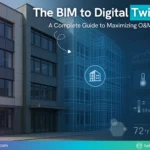BIM & Its Role in the Facility Management
February 10, 2023

Building Information Modelling (BIM), a significant part of the AECO industry, extends its functions to upgrade and expedite a series of processes involved in the lifecycle of a project. One such area is Facility Management, and BIM benefits and strategies trickle down in this function in many layers.
Facility management refers to the management of existing real estate based on the collection, storage, generation, update, and sharing of documents relating to the history of the building (charts, technical datasheets, user manuals, documents, reports, projects, etc.).
In the BIM field, facility management is associated with 7D, the dimension that deals with managing buildings throughout their life cycle.
Let’s understand the role of BIM in Facility Management in depth.
What is the function of BIM in Facility Management?
BIM allows facilities managers to manage the building throughout its lifecycle by providing access to data such as building layouts, electrical and mechanical systems, and equipment specifications in real-time, enabling them to make informed decisions, streamline maintenance and repair processes and improve building performance. It contributes to the enhanced operation, management, financial performance, and maintenance of the building and infrastructure projects.
What role do the BIM models play in Facility Management?
BIM models play a crucial role in facilities management. They provide a clear understanding of the physical characteristics of a building, such as its size, shape, and spatial relationships, which are essential for facilities management activities such as maintenance, repair, and renovation. These models can streamline the building management throughout its lifecycle and provide facilities managers with real-time information about the building and its systems.
How does BIM facilitate the Facility Management Process?
BIM facilitates the facility management process in several ways. Here are a few of them:
- Asset Management: BIM provides facility managers with a comprehensive view of the building’s components and systems, making it easier to plan installations, track, maintain, and replace assets. In addition, it allows a better knowledge of asset locations to resolve issues.
- Space Management: BIM enables facility managers to visualize and manage the occupancy of a building with greater accuracy. There are different industry standards to measure a space, and in BIM, the space is automatically adapted and created as per the area type chosen by the space planner. This simplifies the process for facility managers to test layouts before physically renovating the space.
- Energy and Cost Management: BIM provides facility managers with real-time data about the building’s energy consumption, suggesting alternatives to adopt efficient and environment-friendly methods. It offers solutions to manage budgets and reduce the risk of cost overruns.
- Maintenance Management: BIM enables facility managers to reach their goal of extending the lifespan of an asset at a minimal cost. Therefore, it allows the maintenance of assets in a single facility, multiple facilities, or merely of a group of equipment or machinery.
What are the benefits of BIM in Facility Management?
BIM can be highly beneficial in Facility Management and building operations post-construction. A few of the numerous benefits of BIM to facilities management are:
- Improved Decision-Making and Increased Efficiency: BIM gives facilities managers real-time access to detailed information about a building and its systems, which can inform decision-making and optimize building performance. With facilities management tools, such as Computerized Maintenance Management Systems (CMMS), potential errors can be identified and rectified, thus increasing overall efficiency.
- Streamlined Maintenance and Repairs: BIM can be used to plan and execute maintenance and repair activities, reducing downtime and improving building performance. The comprehensive information provided by BIM can also be used to prioritize maintenance activities, schedule repairs, and ease the future implementation of new equipment and system. O&M Best Practice Guide mentioned that “On average, companies save between 10-12% in costs by investing in preventive maintenance.”
- Enhanced Energy Management and Reduced Energy Waste: BIM models can track energy consumption and identify continuous improvement and energy savings opportunities. By using BIM to optimize building performance, facilities managers can reduce energy waste and decrease the carbon footprint of the building.
Technological advances and increasing demand for enhanced building performance and sustainability will likely shape the future of BIM in facility management. A few potential developments in the future of BIM in facility management include increased integration with IoT, advanced analytics, and interaction with Augmented Reality and Virtual Reality.
Interested in knowing more? Head to our blogs section now!















